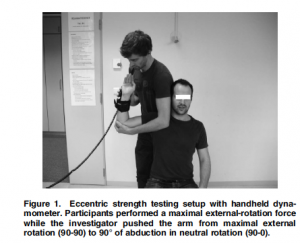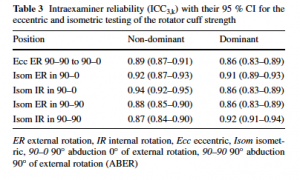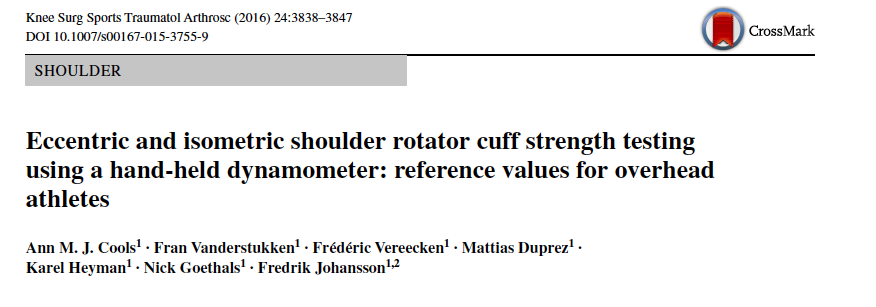The reliability of HHD in measuring upper extremity strength has been favorable in the literature however, reliability may be compromised by testers who are unable to stabilize the device during testing.
Cools et al (2016) describes the following test positions for shoulder HHD testing with excellent inter- and intra reliability, all positions ICC >90.
- (1) eccentric testing of the ER in an abducted position from 90° of ER to 0° of ER
For eccentric strength measurement, the protocol of Johansson et al (2015) was used:

The subject was in a seated position, feet at shoulder width, the lower back supported against a chair, and held the elbow and shoulder at a position of 90° of abduction and 90° of external rotation (90– 90) with support from the examiners hand and forearm.
The HHD was positioned at a point 2 cm proximal of the processus styloideus ulnae and placed on the dorsal side of the forearm.
On the counting of the investigator, controlled by a metronome, the subject performed a maximal external rotation force, while the investigator pushed the arm from maximal external rotation (90–90) to 90° of abduction in neutral rotation (90–0) over a 3-s period. This procedure shows good-to-excellent intra- (ICC = 0.88, SEM = 11.1, %SEM = 9.2, MDC = 33.7) and interrater (ICC = 0.71, SEM = 14.1, %SEM = 12, MDC = 39.1) reliability, as well as good-to-excellent concurrent validity, when compared to the Biodex Isokinetic measurement
- (2 and 3) isometric strength testing of both IR and ER with the shoulder abducted 90° (90–0 position)
- (4 and 5) isometric strength testing of both IR and ER with the shoulder in 90° of abduction with 90° of external rotation (90–90 position)
The isometric testing was performed in a seated position, with the arm supported in 90° of abduction and neutral rotation (tests 2 and 3) or 90° of abduction with 90° or ER (tests 4 and 5). (Riemann et al 2010)
For each test, the participant was asked to perform the glenohumeral ER or IR against resistance of the HHD. A “make contraction” was used rather than a “break contraction”. Participants were asked to build their force gradually to a maximum voluntary effort over a 2-s period and hold the maximal voluntary effort for 5 s. The examiner kept the dynamometer in place, 2 cm proximal of the wrist, by matching the force exerted by the subject
These procedures were found to have good test–retest reliability, excellent intra- and interrater reliability (Cools et al 2016).

Please see article below for reference values for male and female
